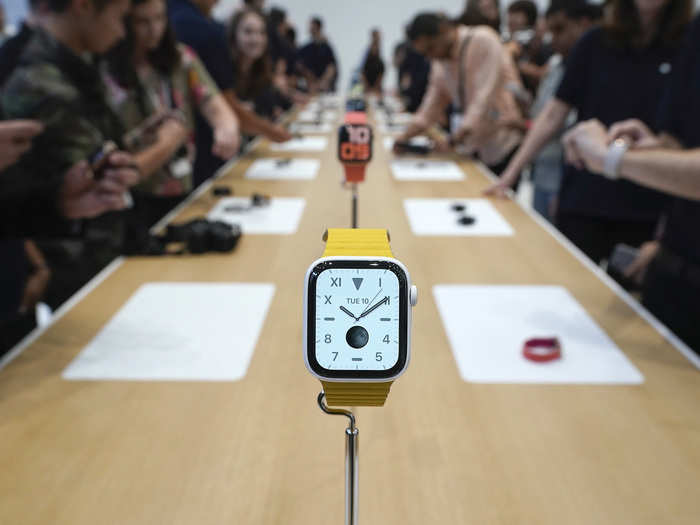
The $200 Fitbit Versa 2, arguably the Apple Watch's biggest rival, also has a display that stays on even when it's inactive. Fitbit's functionality, however, seems very limited compared to Apple's.
All of Apple's watch faces are optimized to work in always-on display mode, which slows the refresh rate down to as low as 1Hz to preserve power. That means you can choose which bits of information you want to see at a glance — like the weather, your next calendar event, or a recent timer — by adding them as complications to your watch face.
It also makes the transition feel more seamless when moving between the low-power always-on display and the regular display. Most of the watch faces I've tried so far on the Apple Watch subtly become brighter and crisper as you raise your wrist to activate the display. For certain clock faces that have metrics that refresh quickly, like the seconds on the Activity Digital watch face, those elements disappear when in always-on mode, and resume when the display is activated.
Even after only using the watch for a couple of hours, I'm noticing how convenient it is to see the time and weather just by looking down at my wrist without having to make any movements or touch the screen.
That's very different from the experience of using the Versa 2's always-on display, which only shows the time, battery life, date, and exercise statistics. It also doesn't transition into its regular display mode automatically when you raise your wrist like this new Apple Watch does.
Take a look at the images below to see what some of Apple's watch faces look like in always-on display mode. You'll notice that they're a bit dimmer than usual.




While you certainly don't need a compass to get from point A to B in 2019, having one definitely makes it easier to do so. The most useful application for the Apple Watch Series 5's compass will likely be the watch's Maps app, since it makes it possible to view the exact direction you're facing so that you can make sure you're going the right way. That can be especially useful for those who live in big cities and often travel by walking or taking the subway, as well as hikers that want to make sure they're staying on the right track.

The Apple Watch's always-on display and built-in compass make the watch much more useful when it comes to two important use cases: telling the time and getting directions.
But if you have a Series 4, you shouldn't feel compelled to upgrade. The always-on display is the Series 5's most appealing new feature, but that alone doesn't justify a $400 purchase. The Serie 4 and 5 share many of the same features otherwise; they even feel the same considering they're both 10.7 millimeters thin and essentially offer the same speed and performance.
I'd give the same advice to most people thinking about upgrading from the Series 3, unless features like the ability to take an electrocardiogram reading and detect hard falls are also of high priority to you — both of which were introduced on the Series 4.
 A couple accidentally shipped their cat in an Amazon return package. It arrived safely 6 days later, hundreds of miles away.
A couple accidentally shipped their cat in an Amazon return package. It arrived safely 6 days later, hundreds of miles away. A centenarian who starts her day with gentle exercise and loves walks shares 5 longevity tips, including staying single
A centenarian who starts her day with gentle exercise and loves walks shares 5 longevity tips, including staying single  2 states where home prices are falling because there are too many houses and not enough buyers
2 states where home prices are falling because there are too many houses and not enough buyers "To sit and talk in the box...!" Kohli's message to critics as RCB wrecks GT in IPL Match 45
"To sit and talk in the box...!" Kohli's message to critics as RCB wrecks GT in IPL Match 45
 7 Nutritious and flavourful tiffin ideas to pack for school
7 Nutritious and flavourful tiffin ideas to pack for school
 India's e-commerce market set to skyrocket as the country's digital economy surges to USD 1 Trillion by 2030
India's e-commerce market set to skyrocket as the country's digital economy surges to USD 1 Trillion by 2030

Copyright © 2024. Times Internet Limited. All rights reserved.For reprint rights. Times Syndication Service.